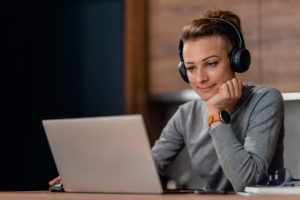
I write this on 23 March. A year ago, the first UK-wide lockdown was declared. It seems like a lifetime away. A time when few owned a face mask, when social distancing and self-isolation were unknown concepts. When we all hoped that this would be over quickly, and life could go back to normal.
The EMDR Association conference 2021 provided an opportunity to reflect on just how many changes this year has brought. In fact, since the conference was held entirely online, it was impossible to forget just how dramatically our lives have been affected by the pandemic. As we entered the virtual conference hall, each presentation was slightly different to how it would have been had we been in Glasgow. Nothing was unaffected.
The discussion has moved very far from that of a year ago, when we were asking whether EMDR online was possible at all. Instead, we were already hearing about research confirming its effectiveness. There was even a presentation indicating that it might be more effective than EMDR in person. Remote EMDR was so entirely part of the conference that it’s difficult to remember just how quickly this change has occurred.
Working online has been inevitable for most of us. And in learning how to work online we discovered that many of our fears were unfounded. Our clients have taken the risk, just as we have, and we have created therapeutic spaces over the internet. As we move into the second year of the pandemic, our understanding of online EMDR therapy is maturing. I have had to replace the anonymity of my clinic room with a room in my home. Clients therefore know that I am also living through this pandemic, also locked down, and often that I also have children who are not at school because they can hear them. They know more about me than they would have done before and, likewise, I see a different side to them.
I am confident that online EMDR will never retreat to the shadows.
As the year goes on, we became more aware of the impact of moving our work and lives online. At the conference, I missed the informal interactions and chance to chat over coffee and go out to dinner. With clients, I miss the chance to see them in person, to feel their presence in the room. Coming to a therapy session in person often involves many different social interactions, for me and for the client. The importance of these low-level interactions has been one of the great lessons of the pandemic for me. When every conversation is intentional, I lose spontaneity and the possibility of unexpected connections. I haven’t worked out a way to replicate this online and I wonder if in the future we will.
This time last year, EMDR Training was brought to an abrupt halt. The free EMDR online webinars put on by the Association were the first online events ever to be awarded CPD points. It wasn’t at all clear how training would develop, and there was a period of extended uncertainty whilst different recommendations came in from EMDR-Europe and everyone tried to adapt to the rapidly changing rules. It is now possible to do all your basic EMDR training online, as well as to attend CPD events. For many therapists, this has meant they can access more training and events have been extremely well attended as a result.
We are now producing a generation of EMDR therapists for whom remote working may feel as natural as in-person therapy. Again, the speed of change is impressive. Online training is clearly effective and trainees have been positive. As with therapy, training online isn’t exactly the same, and there are advantages and disadvantages. As a facilitator, I miss the buzz of the room and the chance to make new informal connections, whilst appreciating how we can carry on.
Spring is here, and there is hope that 2021 will be different. The optimism of vaccines and schools reopening is balanced with the risk of new variants and ongoing high levels of infection. I think we can be proud of how quickly the EMDR community adapted to this new way of working. As we look to the year ahead, what do we want to take forward from this period of intense change?
I have been developing resource images with clients of their resilience during this difficult time. We think about what they would like to take forward, and how they can acknowledge the learning of this time as well as the pain and losses. For the EMDR community, I see us as a tree, growing new branches and buds as we learn more about how to work in this new way, whilst being deeply rooted in experience. Some branches wither and some flourish, but we continue to grow. We will respond to the circumstances and adjust, just as we have done this year.
Whatever happens, I am confident that online EMDR will never retreat to the shadows. We will continue to develop new ways of working, and to reflect on how remote EMDR is different, whilst also being the same. As it becomes a choice, rather than a necessity, we will face more decisions about when it is appropriate and when in-person meetings are preferable. The challenge for now, as I see it, is to do the research, get the papers out there and show the world that EMDR isn’t just possible online, but it really works.
Dr Naomi Fisher is a clinical psychologist and EMDR Consultant and Training Facilitator who works with adults and children. She works in online private practice in Hove, England.






